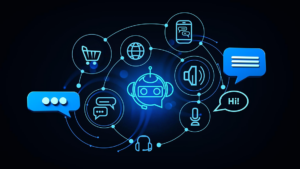

Sampath Kumar Arunachalam
Metaverse - Going Beyond Digital Customer Experience in Retail
Since Facebook rebranded itself as Meta, the metaverse became a new buzzword raising the expectations in all areas of the industries, including the retail sector.
Today, there are multiple technologies like virtual reality headsets, augmented reality technologies, blockchain, cryptocurrencies, non-fungible tokens and much more than literally changing the way of life. Since the pandemic, retail has never been more evolving than now. As the metaverse is growing, the future of retail can also expand beyond the existing digital customer experience.
Let us see what metaverse can offer the retail industry and what needs consideration while creating the customer experience.
What is Happening with the Metaverse
In 1992, sci-fi writer Neal Stephenson coined the term ‘metaverse’ described as a 3-D virtual space. It is a parallel reality platform created by different virtual worlds to form a seamless universe. Today’s internet interaction is asynchronous. However, in the metaverse, it is considered synchronous. i.e., you can ultimately interact with people, places, and things in real-time synchronously.
People have been talking about the metaverse concept for more than two decades. However, due to the recent pandemic, the shift in the lifestyle has accelerated the thoughts of this alternate parallel reality where people can interact in real-time, at any time with others without worrying about facemasks, social distancing, and home isolations. In the metaverse, one can travel without restriction whenever and wherever (at whatever timeline of history) they wish.
Companies are building the basic blocks for these platforms. So far, Meta (previously Facebook), Microsoft, NVIDIA, Unity, and a few more are already trying to build for the metaverse. A popular online social game “Fortnite” showed a glimpse potential of the metaverse when it launched at a live music concert within the game’s virtual space. Recently Feb. 4, 2022, a metaverse wedding was held in Arizona. Most applications have a built-in metaverse for improving work productivity, interactive learning environments, e-commerce, real estate, and fashion. As tech companies join the show, the future of metaverse will be a combination of reality technologies like AR, VR, and MR to transform the way we work.
What Is in It for Retail
When it comes to retail, transporting just the shopping concepts and conventions of the industrial age into this new world will be ineffective and less creative. Whereas creating the replica of shopping venues, stores, malls, etc., would be a short-sighted view, we need to think differently to use the potential of virtual reality. E.g. There can be a whole walkthrough of the tea plantation on how to choose or allow you to pick your tea leaves, process them and have them delivered to the real-world home. Creativity can move retail customer experience beyond the existing and current digital shopping experience.
As people start engaging in multiple activities inside a metaverse, virtual fashion or identities such as clothing, jewellery, shoes, and more have become essential like in the real world. Brands can capitalise on these virtual products as they are a status symbol in real and virtual realities. Some of the more prominent brands have already taken baby steps. For example, Ikea has successfully employed AR technology to allow the customer to design spaces using their Studio App. L’Oréal has built an entire line of virtual cosmetics. Gucci designed virtual sneakers for app users in Roblox and VR Chat.
What Should Be Considered While Creating an Experience for Retail Metaverse
The Ecosystem
The immersive experience inside the metaverse ecosystem relates to various factors such as the infrastructure support (5G, WiFi6), the human interfaces (Mobile, Smart glasses, wearables, voice), spatial computing/blockchain and more. Some of these factors are developing, and some must get refined to reach every person.
The Immersive Experience
Metaverse will be an extension of the existing internet. It provides a platform to enable the marketplace, sell products, facilitates support and training. It also helps in sharing the content through various social channels. Metaverse can also allow these and expand to include immersive shopping experiences. The engagement is restrictive only to pages and apps on the current internet. Still, for the immersive experience, it is all about the activities done by the people, i.e., interaction extends from click tap to various actions. From the retail perspective, the immersive experience should help customers from any part of the world to make purchase decisions by engaging them effectively.
The Challenges
The metaverse can bring a significant change, but it might also possess even greater challenges. Even though there is a developing version of the technology in the market, the system lacks interoperability. A metaverse is a group of worlds where the data is seamless from different system parts. Within the systems, the challenges of data storage, privacy, and security may arise. Even legal and jurisdictional systems are not entirely developed and might put users and retailers at risk without proper regulations.
The currency and the payment system will also pose a significant challenge. As there can be numerous physical and digital currencies evolving, the challenge will be to persuade users to rely on them and make them comfortable. Accessibility to the expensive hardware and internet will also hinder the virtual ecosystems.
The Road Ahead
The metaverse is in its initial stages, and it might evolve just like the internet. Though it is not advancing faster than its sceptics, Tech industries believe that metaverse will reach 1 Billion people by 2030. A new era may dawn; when it does, every retailer’s focus is to consider their customer demographics and cater for a better experience on the metaverse.
Retailers, marketers, experience designers, brands, and others will have to begin thinking very differently about what a “store” is and what kind of an experience they leave to their customers. Get in touch with the experts at ACL Digital for more information.
References
https://www.theverge.com/2019/2/2/18208223/fortnite-epic-games-marshmello-concert-exciting-bizarre-future-music
https://www.theverge.com/2021/3/19/22340621/gucci-virtual-25-sneaker-ar-vrchat-roblox
https://tcrn.ch/2IuZiLv
https://medium.com/building-the-metaverse/the-experiences-of-the-metaverse-2126a7899020
https://www.fox10phoenix.com/news/what-is-the-metaverse-one-of-the-hottest-trends-in-the-tech-world-in-recent-months
https://sensortower.com/blog/metaverse-apps/



